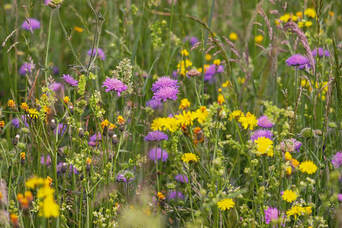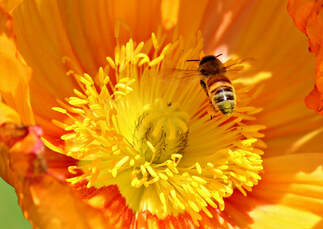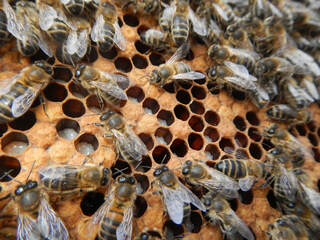Fuel for Life
We are about to stray for a while from the main Caterpillar Foodplant theme of our website to discuss Nectar Plants, but without losing sight of the fact that without caterpillar foodplants there wouldn't be any adult butterflies to drink the nectar.
An abundant supply of nectar is essential to fuel the activity of many - but by no means all - butterflies and moths, as they fly around urgenty in search of a mate and a suitable place to lay their eggs.
Limited Caterpillar Foodplant Choices
As we have seen, butterflies are highly selective in their choice of leaves and buds on which to lay their eggs, owing to the need to provide a high quality, nutritious diet for their caterpillars. This usually means the fresh, tender leaves of a small number of species growing in a warm, sheltered spot. The leaves also need to provide camouflage, and in many cases toxic chemicals that the caterpillars can safely concentrate within their bodies to make themselves unpalatable to birds and other predators.
In these days of shrinking habitats, finding the right plant in the right place at the right time becomes more and more difficult.
We are about to stray for a while from the main Caterpillar Foodplant theme of our website to discuss Nectar Plants, but without losing sight of the fact that without caterpillar foodplants there wouldn't be any adult butterflies to drink the nectar.
An abundant supply of nectar is essential to fuel the activity of many - but by no means all - butterflies and moths, as they fly around urgenty in search of a mate and a suitable place to lay their eggs.
Limited Caterpillar Foodplant Choices
As we have seen, butterflies are highly selective in their choice of leaves and buds on which to lay their eggs, owing to the need to provide a high quality, nutritious diet for their caterpillars. This usually means the fresh, tender leaves of a small number of species growing in a warm, sheltered spot. The leaves also need to provide camouflage, and in many cases toxic chemicals that the caterpillars can safely concentrate within their bodies to make themselves unpalatable to birds and other predators.
In these days of shrinking habitats, finding the right plant in the right place at the right time becomes more and more difficult.

A Bigger Choice of Nectar
In contrast, when it comes to satisfying their own thirst for nectar, butterflies are far less selective. But they do have preferences, and to attract as many types of butterfly to your green space or garden as possible, the wider the range of nectar plants the better.
Most commercial seed mixes contain twenty or so. They are typically selected by the suppliers to provide nectar over as long a season as possible, from when the first butterflies emerge from hibernation in spring right through to when the second or third brood are on the wing as autumn approaches.
They also include species with long-tubed flowers for those bees, butterflies and moths that have a long proboscis.
In contrast, when it comes to satisfying their own thirst for nectar, butterflies are far less selective. But they do have preferences, and to attract as many types of butterfly to your green space or garden as possible, the wider the range of nectar plants the better.
Most commercial seed mixes contain twenty or so. They are typically selected by the suppliers to provide nectar over as long a season as possible, from when the first butterflies emerge from hibernation in spring right through to when the second or third brood are on the wing as autumn approaches.
They also include species with long-tubed flowers for those bees, butterflies and moths that have a long proboscis.
Nectar-rich Wildflower Mixes for Every Location
Most good commercial suppliers have mixes geared for specific types of terrain. Scotia seeds for example have an especially intriguing selection, which includes a Dry Meadow Mix, Wet Meadow Mix, Flowering Lawn Mix, Hedgerow Meadow Mix, Northern Haymeadow Mix, Highland Grassland Mix, Coastal Meadow Mix, Urban Pollinator Meadow Mix, Green Roof Mix, Bee, Bird and Butterfly Mix, Coastal Dry Places Wildflower Mix, Flowering Lawn Wildflower Mix, get Nectar-rich Quick Mix, Haymeadow Wildflower Mix, Hedgerow Wildflower Mix, Pond-edge Wildflower Mix, Wetland Wildflower Mix and a Woodland Wildflower Mix.
With most of the hard work having already been done for us by the seed companies, it’s just a case of deciding which mix best fits our location, and if we have special favorites or want extra caterpillar foodplants, adding them to it.
Some wildflowers are tolerant of a wide range of conditions and appear in most mixes, while others are far more dependent on specific conditions of sun or shade, wet or dry, chalk or acid soils and so on..
A word of caution. There are some wildflower mixes on the UK market which turn out to include the wildflowers of America, South Africa and elsewhere. They may produce just as much nectar and pollen as British wildflowers but our insects have not evolved to use them as larval food plants, so do as they do, and avoid them. Always make sure that you only choose companies like Scotia Seeds, Emorsgate and others that either grow their own stock in the UK or source it from growers who do. Most of our wildflowers also grow on mainland Europe, but in order to keep your stock pure, whatever part of the world you live in, buy as locally as possible.
Most good commercial suppliers have mixes geared for specific types of terrain. Scotia seeds for example have an especially intriguing selection, which includes a Dry Meadow Mix, Wet Meadow Mix, Flowering Lawn Mix, Hedgerow Meadow Mix, Northern Haymeadow Mix, Highland Grassland Mix, Coastal Meadow Mix, Urban Pollinator Meadow Mix, Green Roof Mix, Bee, Bird and Butterfly Mix, Coastal Dry Places Wildflower Mix, Flowering Lawn Wildflower Mix, get Nectar-rich Quick Mix, Haymeadow Wildflower Mix, Hedgerow Wildflower Mix, Pond-edge Wildflower Mix, Wetland Wildflower Mix and a Woodland Wildflower Mix.
With most of the hard work having already been done for us by the seed companies, it’s just a case of deciding which mix best fits our location, and if we have special favorites or want extra caterpillar foodplants, adding them to it.
Some wildflowers are tolerant of a wide range of conditions and appear in most mixes, while others are far more dependent on specific conditions of sun or shade, wet or dry, chalk or acid soils and so on..
A word of caution. There are some wildflower mixes on the UK market which turn out to include the wildflowers of America, South Africa and elsewhere. They may produce just as much nectar and pollen as British wildflowers but our insects have not evolved to use them as larval food plants, so do as they do, and avoid them. Always make sure that you only choose companies like Scotia Seeds, Emorsgate and others that either grow their own stock in the UK or source it from growers who do. Most of our wildflowers also grow on mainland Europe, but in order to keep your stock pure, whatever part of the world you live in, buy as locally as possible.

Nectar-rich, but What About the Pollen?
Should we focus on those wildflowers that produce most nectar, most pollen, or both?
Our native butterflies don’t eat pollen – bees do, but not butterflies - so if our aim is solely to attract butterflies, It’s their yield of nectar that will be of most interest to us.
If our aim is also to provide sustenance for a colony of honeybees or bumblebees the yield of pollen will be more important.
We must avoid confusing the lifestyle and diet of bees with that of other insects because bees are extremely unusual insects for at least two reasons. Firstly their larvae are cared for and fed by the adults. A few other kinds of social insect including ants and termites and some wasps adopt a similar strategy, but the vast majority of insects, including butterflies and moths, after carefully choosing an auspicious place to lay their eggs - in terms of camouflage and proximity of food - leave their larvae to fend for themselves.
Should we focus on those wildflowers that produce most nectar, most pollen, or both?
Our native butterflies don’t eat pollen – bees do, but not butterflies - so if our aim is solely to attract butterflies, It’s their yield of nectar that will be of most interest to us.
If our aim is also to provide sustenance for a colony of honeybees or bumblebees the yield of pollen will be more important.
We must avoid confusing the lifestyle and diet of bees with that of other insects because bees are extremely unusual insects for at least two reasons. Firstly their larvae are cared for and fed by the adults. A few other kinds of social insect including ants and termites and some wasps adopt a similar strategy, but the vast majority of insects, including butterflies and moths, after carefully choosing an auspicious place to lay their eggs - in terms of camouflage and proximity of food - leave their larvae to fend for themselves.

Secondly, bees feed their larvae, as well as themselves, on nectar and pollen, in contrast to butterflies and most other insects in which the diet of the adult is usually very different from that of the larvae. Adult butterflies imbibe sugary drinks themselves whilst leaving their caterpillars to a diet of leaves and buds.
Even adult butterflies that drink nectar from flowers (with some specialised tropical exceptions) confine themselves to the nectar, ignoring the flower's pollen, although they might get contaminated by it and carry it to the next flower they visit, inadvertently fertilising it.
Even adult butterflies that drink nectar from flowers (with some specialised tropical exceptions) confine themselves to the nectar, ignoring the flower's pollen, although they might get contaminated by it and carry it to the next flower they visit, inadvertently fertilising it.
Setting up Home
Once we have equipped our area of land with nectar stations at which passing butterflies can refuel, we don’t really want them to continue their journey. We would prefer them to stay, set up home and produce the next generation. So if we wish to create a breeding ground for butterflies, the next step is to see how well the commercial pollinator mixes supply the necessary caterpillar food plants.
Equip the Home with Foodplants for the Caterpillars
It’s easy enough. Just go through a list such as ours of caterpillar food plants, and identify those suitable for the caterpillars of the butterflies likely to be flying in your part of the country. Then check that they are included in the commercial wildflower mixes of interest to you, and if they are not - usually because they are not into producing pretty wild flowers for pollinators – simply purchase them separately, either as seeds or plug plants.
The advantage of plug plants is that they provide a head start over everything else growing from seeds. To persuade butterflies to actually breed in your garden rather than just stopping briefly to refuel at its nectar pumps, it’s important that the caterpillar foodplants always take precedence.
Once we have equipped our area of land with nectar stations at which passing butterflies can refuel, we don’t really want them to continue their journey. We would prefer them to stay, set up home and produce the next generation. So if we wish to create a breeding ground for butterflies, the next step is to see how well the commercial pollinator mixes supply the necessary caterpillar food plants.
Equip the Home with Foodplants for the Caterpillars
It’s easy enough. Just go through a list such as ours of caterpillar food plants, and identify those suitable for the caterpillars of the butterflies likely to be flying in your part of the country. Then check that they are included in the commercial wildflower mixes of interest to you, and if they are not - usually because they are not into producing pretty wild flowers for pollinators – simply purchase them separately, either as seeds or plug plants.
The advantage of plug plants is that they provide a head start over everything else growing from seeds. To persuade butterflies to actually breed in your garden rather than just stopping briefly to refuel at its nectar pumps, it’s important that the caterpillar foodplants always take precedence.